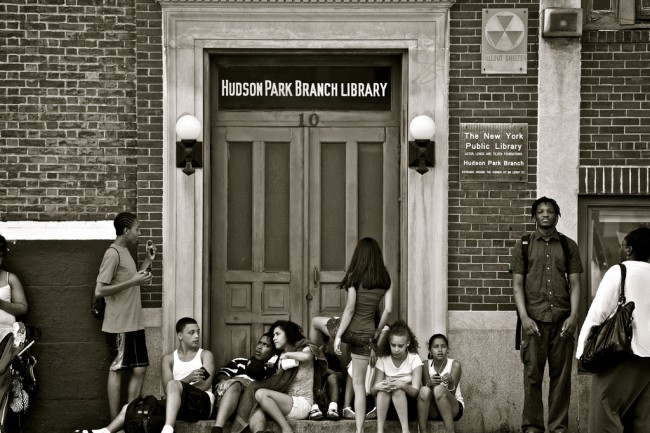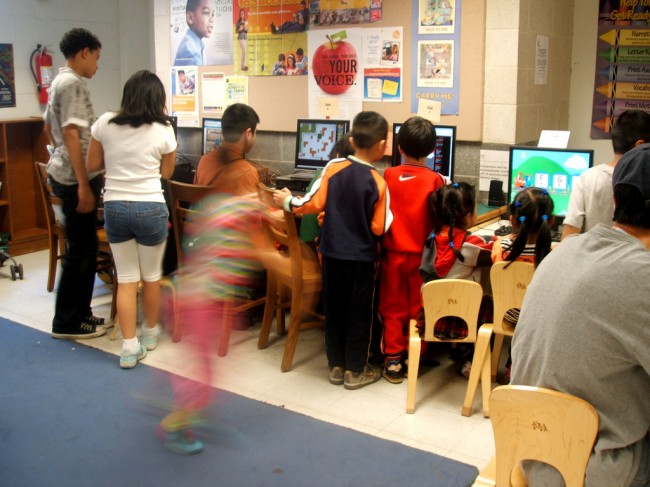
We are celebrating 15 years — and counting — of stories that are deeply researched and deeply felt, that build a historical record of what the city has been.
We are celebrating 15 years — and counting — of stories that are deeply researched and deeply felt, that build a historical record of what the city has been.

Photo via Alex Proimos
Request for Qualifications (RFQ)
Re-envisioning Branch Libraries
A project organized by the Center for an Urban Future and The Architectural League of New York
Submission Deadline: June 20, 2014
Pre-registration encouraged by June 9, 2014
Download a PDF of this RFQ
Update: Download answers to a list of Frequently Asked Questions regarding the RFQ
Branch libraries are serving more New Yorkers in more ways than ever before, yet they remain undervalued by policymakers. This summer, The Architectural League is collaborating with the Center for an Urban Future on a design study that will articulate new architectural, financial, and programmatic possibilities for these essential, neighborhood-based resource centers. Over the next few months, we will periodically be releasing features here on Urban Omnibus and on ArchLeague.org that explore different aspects of branch libraries in New York, touching on the diverse architectural forms of this particular public building type as well as investigating the vast proliferation of vital services they provide. This series of online content will complement and inform the design study, leading up to a public event this fall where participants in the design study will present their work. This event will include broad-based discussion with advocates and policymakers about the challenges and opportunities facing branch libraries.
The challenges that branch libraries face include enabling access to the burgeoning resources of the digital world while continuing to circulate books and other print resources; enhancing capacity to serve as physical and civic hubs of their communities; and accommodating the full range of programs they offer, from adult literacy and ESL to after-school programs for children and teens and technology training for senior citizens.
We invite architects and designers interested in participating in this design study to organize interdisciplinary teams and to submit qualifications and a statement of interest in response to the Request for Qualifications, accessible here. A selection committee will recommend up to six teams to participate in the design study. The designs generated will be used to provoke conversation about how best to support the library systems through design, funding, and public awareness of the vital services they provide.
Background
New York City’s 211 branch libraries provide vital social infrastructure for the empowerment of communities and their residents. Some of this empowerment is economic: library programs offer opportunities for skill-building and life-long, non-institutional learning — opportunities that support those New Yorkers eager to share their skills and knowledge, those who seek a “third place” to investigate and incubate new business opportunities, and those who lack the basic language, literacy, and technological skills needed to access decent paying jobs. And some of this empowerment is personal and civic: libraries are social hubs, providing crucial services, including child care and language acquisition workshops, and affording both individual and collective opportunities for the free acquisition of knowledge.
Yet, a range of obstacles — financial, political, and architectural — prevents New York from realizing the full potential of its branch libraries. Few libraries are open more than 40 hours a week. A majority of the buildings were built before 1975 — many before 1929 — and are now in urgent need of physical upgrades. Older library designs do not respond to the usage patterns of specific user groups — like seniors, teens, or recent immigrants — and even some newer branches are poorly configured for contemporary programs, with insufficient space for classes, collaboration, or computers. The proliferation of services libraries provide suggests a rethinking of the spatial organization of staff and users, quiet and loud, private and public, physical and digital resources. The adoption of new technologies has only just begun. Demand for library services is very high but not evenly distributed: some branches are prohibitively congested, while others have underutilized spaces that could be re-imagined for new uses, such as small business incubators, co-working spaces, community rooms, or classrooms.
The libraries need new options and ideas. How might branch libraries realize efficiencies in their existing physical plants? How could programming expand beyond the footprint of their buildings? What other models of service delivery — on-site or off-site, through partnerships, pop-ups, and more — are applicable? What are the design, technology, and infrastructure innovations needed for neighborhood libraries to meet the demands and context of urban community life in the 21st century?

The Sunset Park branch of the Brooklyn Public Library | Photo via Krissa Corbett Cavouras
Design Study
Last year, CUF published Branches of Opportunity, a report that details how New York City’s three library systems serve more people in more ways than ever before, yet remain undervalued by policymakers. In early July, CUF will publish a follow-up report, a “blueprint” that extensively documents the physical plant and capital needs of New York City’s branch libraries. The release of this blueprint will coincide with the launch of a three-month design study, directed by The Architectural League. Over the course of the study, up to six interdisciplinary design teams will address questions of location, development strategy, financial feasibility, operation, spatial organization, and architectural form.
Possible approaches to the architectural, financial, and programmatic limits of existing branch libraries are numerous: reimagining existing buildings and reconfiguring interior and exterior space; pursuing creative partnerships with a variety of non-profit and for-profit entities; identifying potential new sources of revenue; adapting to demographic changes in the city, including the growth in the size of the senior and recent immigrant populations; acknowledging and responding to the use of city capital funds.
To investigate some of these approaches, design study teams will produce design concepts and development strategies, communicated through narrative descriptions, financial scenarios, drawings, and other means as appropriate. The Architectural League will provide the selected teams with background materials including specific design challenges and CUF’s two reports on branch libraries. (Branches of Opportunity can also be accessed here.) Architectural League staff will interact with and provide guidance to design teams at a number of points during the design study process.
Each team will present its work at a public event in the fall of 2014, which will be attended by leaders from public policy and cultural institutions, the library systems, and city government. The Architectural League will work closely with each team to refine ideas and communication strategies for this event.
Selection Committee
Seema Agnani, Chhaya Community Development Corporation
Sarah Goldhagen, The New Republic
Henry Myerberg, HMA2 architects
Lyn Rice, Rice+Lipka Architects
and members of the project team
Request for Qualifications
For more information on the design study, complete submission instructions, or to signal interest in participating, read the full Request for Qualifications and answers to a list of Frequently Asked Questions. Pre-registration is encouraged by June 9th, and the deadline for submission of materials is June 20th.

The views expressed here are those of the authors only and do not reflect the position of The Architectural League of New York.